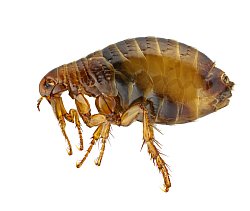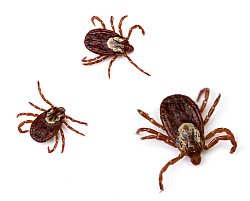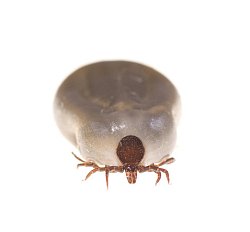 Spring has sprung in most parts of Canada by now. With the warmer
temperatures, it's time once again to think about flea and tick awareness.
Fleas and ticks can be found
in outdoor spaces where we spend time with our pets, whether we're out
hiking with the dog or simply working in the yard and garden.
Spring has sprung in most parts of Canada by now. With the warmer
temperatures, it's time once again to think about flea and tick awareness.
Fleas and ticks can be found
in outdoor spaces where we spend time with our pets, whether we're out
hiking with the dog or simply working in the yard and garden.

Flea / (c) Can Stock PhotoWhat are fleas? Fleas are tiny, blood-sucking wingless insects that are known for their jumping ability. In size, they're typically somewhere between 1 millimetre (like a grain of sand) to 3 mm (like a sesame seed). They are usually brown in colour, often appearing darker brown after they've fed. Fleas also lay a lot of eggs. The eggs are white and can be difficult to see, about 1/2 mm in size. The eggs hatch and become flea larvae - also white, a couple of mm long, looking like small white caterpillars.
How does my pet get fleas? Fleas can be found anywhere in the environment. Other animals who have fleas (such as wildlife or stray cats and dogs) wander around. Female fleas drop their eggs into the environment as the animal passes. The eggs hatch and eventually become adult fleas who jump onto pets, who may also lay eggs on your pet. These eggs will hatch into adults, who may lay more eggs, and a vicious cycle develops unless the problem is treated.
How can I spot fleas on my pet? Pet owners might catch a glimpse of adult fleas as they migrate around the pet. Fleas can be anywhere on the body but seem to congregrate more commonly in hard-to-reach areas (for the pet) like the belly, the armpits, the thighs, back, rump, and the tail.
Sometimes pet owners may see small black flecks of "dirt" which are actually flea droppings. To see if they're dirt or flea droppings, use a tissue to pick up a bit of the 'dirt' and then wet the tissue and wait a few minutes. If it's flea droppings, you'll see the red of the digested blood on the wet tissue.
Signs that your dog may have a flea problem include excessive scratching or biting at his body (especially in the areas mentioned above), or tearing away his fur. The most typical sign in cats is obsessive or over-grooming. A flea comb can be useful in helping check your pet for fleas. These fine-toothed combs are specifically designed to help remove fleas from pets.
How are fleas bad for my pet? Fleas inject saliva into the skin of the pet and feed on their blood. Fleas can cause intense itchiness, redness and discomfort in pets. Some pets become severely allergic to flea bites and will scratch themselves raw and tear out their own fur in an attempt to stop the itching. A heavy flea infestation can even cause a pet to become anemic and die.
How can I prevent fleas? Vets sell prescriptions to prevent fleas and to kill both the eggs and the adults. Ask them what is the best and safest solution for your pet. Some people don't like using chemicals on their pets. These medications have been extensively tested for safety, however there are (rare) accounts of pets having bad reactions to them. Most pets do not react negatively to flea preventive but it is a judgment call for the owner to decide if it's the right choice.
Can't I just get rid of fleas if my pet gets them, instead of treating them beforehand? Yes, you can. A flea preventive prescribed by your vet can kill the eggs and adult fleas... but what do you do about the fleas and the eggs that have dropped off your pet and into your yard and your home, including the carpets? It is a stressful and potentially time-consuming, expensive process to rid a home of fleas. There are some safer, natural ways to exterminate fleas but sometimes it won't be enough and you may end up requiring the help of professional exterminator.

Dog ticks / (c) Can Stock Photo
Engorged tick that has fed on blood
/ (c) Can Stock PhotoWhat is a tick? A tick is a tiny parasite that feeds on blood. They can be very hard to see, around 1/2 millimetre in size (can be mistaken for a speck of dirt, about the size of a poppy seed)... or they can be up to around 3 mm (similar in size to a sesame seed). Ticks are flat until they have fed - then they become engorged to many times their original size.
How does my pet get ticks? Ticks are often found in the woods, or in areas where there are low shrubs or tall grass. They climb one to two feet from the ground up into the shrubs or grass and there they wait, until an animal brushes by them and they can crawl onto it. It's not just our pets that can get ticks... we humans can get them too!
How are ticks bad for my pet? Ticks can transmit a number of diseases including Lyme disease and Rocky Mountain spotted fever, depending on the type of tick. Talk to your vet about how concerned you need to be about your pet picking up a tick-borne illness. The site of the bite should also be monitored for signs of infection, especially if ticks aren't removed completely (leaving the head or mouth parts inside the pet), or are squeezed as they are being removed (emptying their contents back into the pet).
How can I prevent ticks? We have used medication to prevent ticks before, and our dogs still get ticks. The medication apparently only works on certain types of ticks (the kind that causes lyme disease) ... so pet owners still have to be vigilant. Carefully check your pet after every adventure outside during tick season. Be especially viligant around the pet's armpits, ears, in between the paw pads, and around the neck against the skin.
Can't I just get rid of ticks if my pet gets them, instead of choosing preventive treatment? Yes. The key is to remove the entire tick. Sometimes it can be hard to get the whole thing out and instead the body comes off but the head remains embedded in the pet's skin. In this case, you need to watch the tick bite area carefully for signs of infection.
- You can learn to pull a tick off yourself (not too difficult, other than the 'ick' factor): using fine-pointed tweezers or your fingers (put some tissue in between your fingers and the tick, or use a rubber glove), grasp the tick as close to the pet's skin as possible. Place your other hand against your pet's skin to prevent it from being pulled uncomfortably upwards. Exert steady pressure and pull straight up until the tick is out. You may be surprised at how much pressure it takes! If you are successful, the entire tick will be pulled out and you'll see the legs wiggling. Place the tick in alcohol to kill it. You may want to keep it for a few days just in case your dog has a reaction - the type of tick will be easier to identify if you still have the body.
- Use a tool like a tick key to help you pull off the whole tick quickly and painlessly. These small tools are easy to use - simply slide the key over the body of the tick until it's caught in the narrow side of the key, and then pull to remove the tick.
- Take your pet to the vet. If you are uncertain or uncomfortable removing a tick on your own, ask your vet to show you how to do it.
Ticks aren't always easy to spot. They can start off very small and barely noticeable. Once they start feeding, they will gradually get bigger and will be much easier to spot. Groom your pet regularly after he or she has spent time outdoors. It will help you spot ticks faster so that they can be removed, sometimes even before they have attached and started feeding.
There a few things you can do to help minimize the chances that your pet will come into contact with fleas or ticks. First, keep your yard tidy - grass should be clipped short, shrubs trimmed, and excess leaf or plant debris cleared away. Second, stick to cleared trails when out hiking with your dog and don't allow dogs to run through long grass or bush. Third, talk to your vet about whether or not it is necessary to treat your pet with a flea or tick preventive.
Finally, if you're travelling to another location, ask your vet if your pet needs a flea or tick preventive for the trip - it might not be warranted while you're at home, but every part of the country is different.
"Dogs laugh, but they laugh with their tails." (Max Eastman)